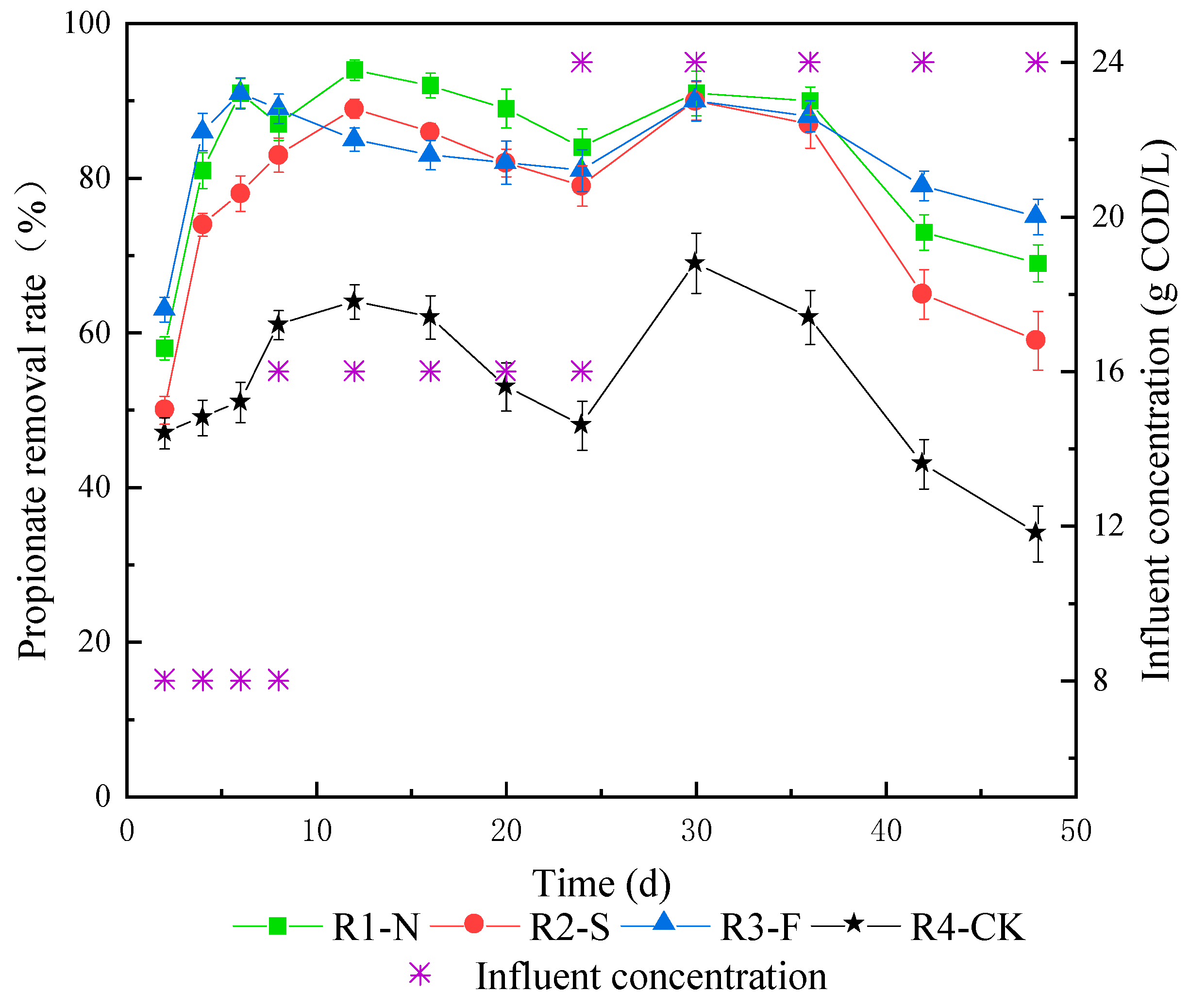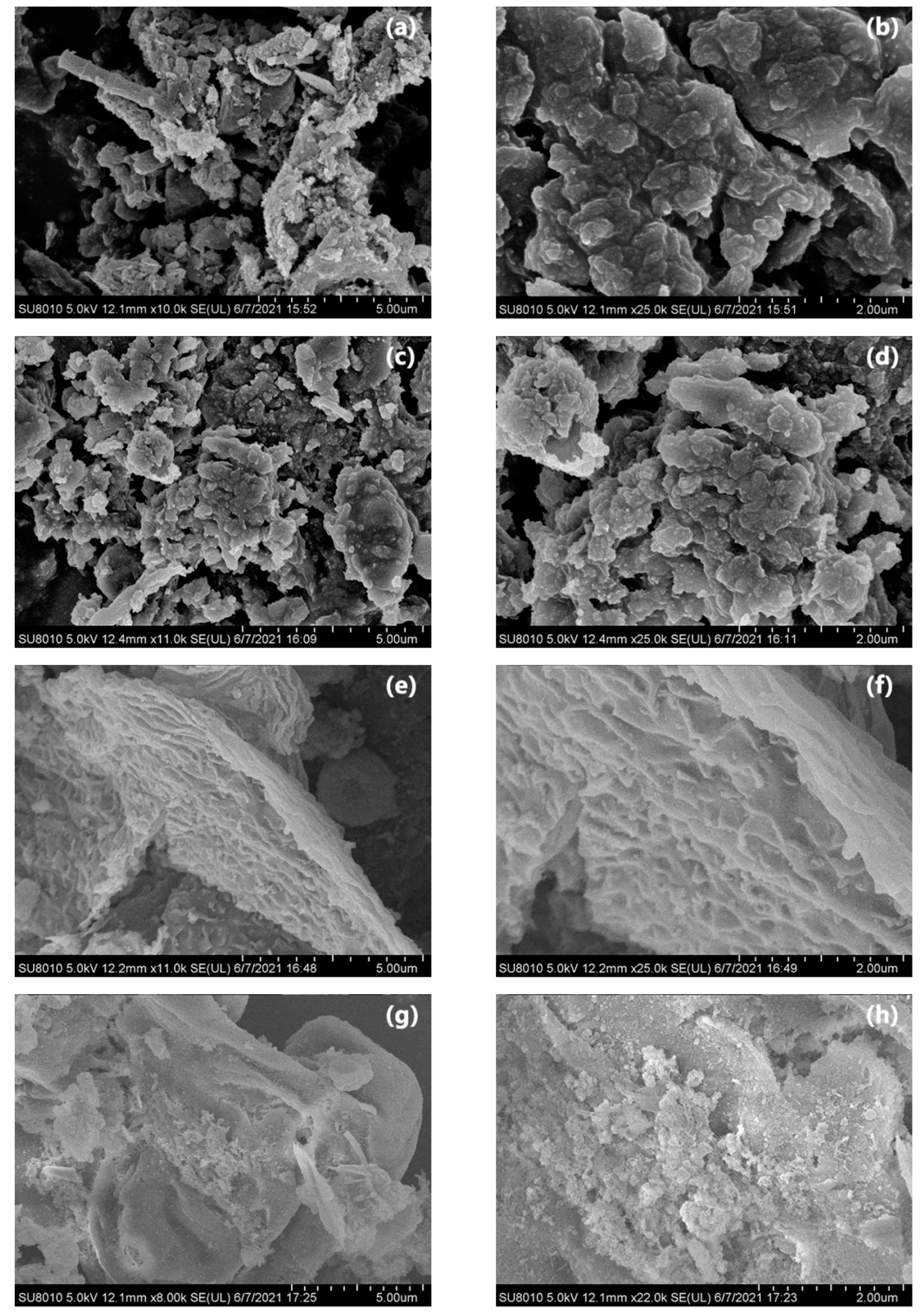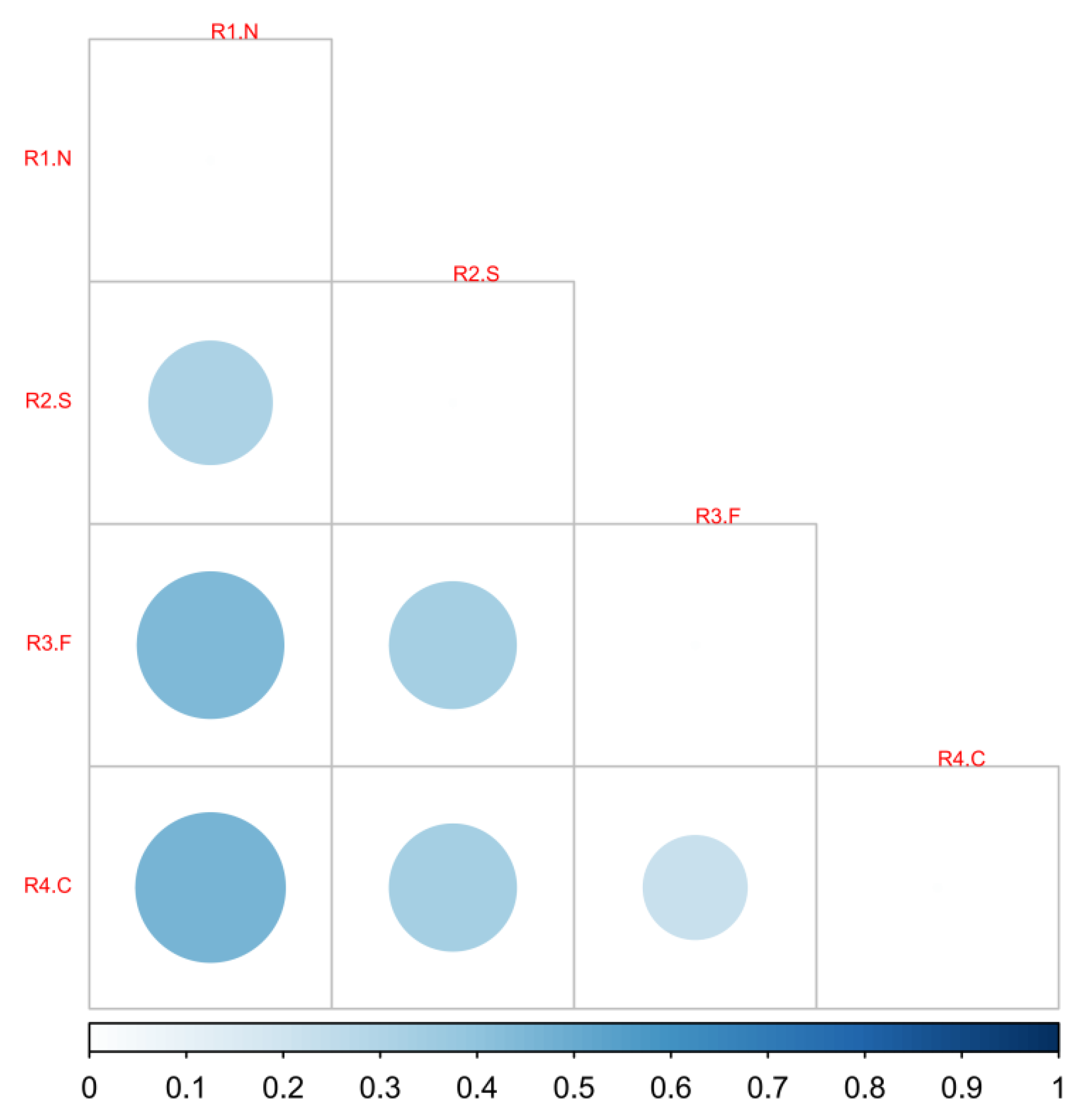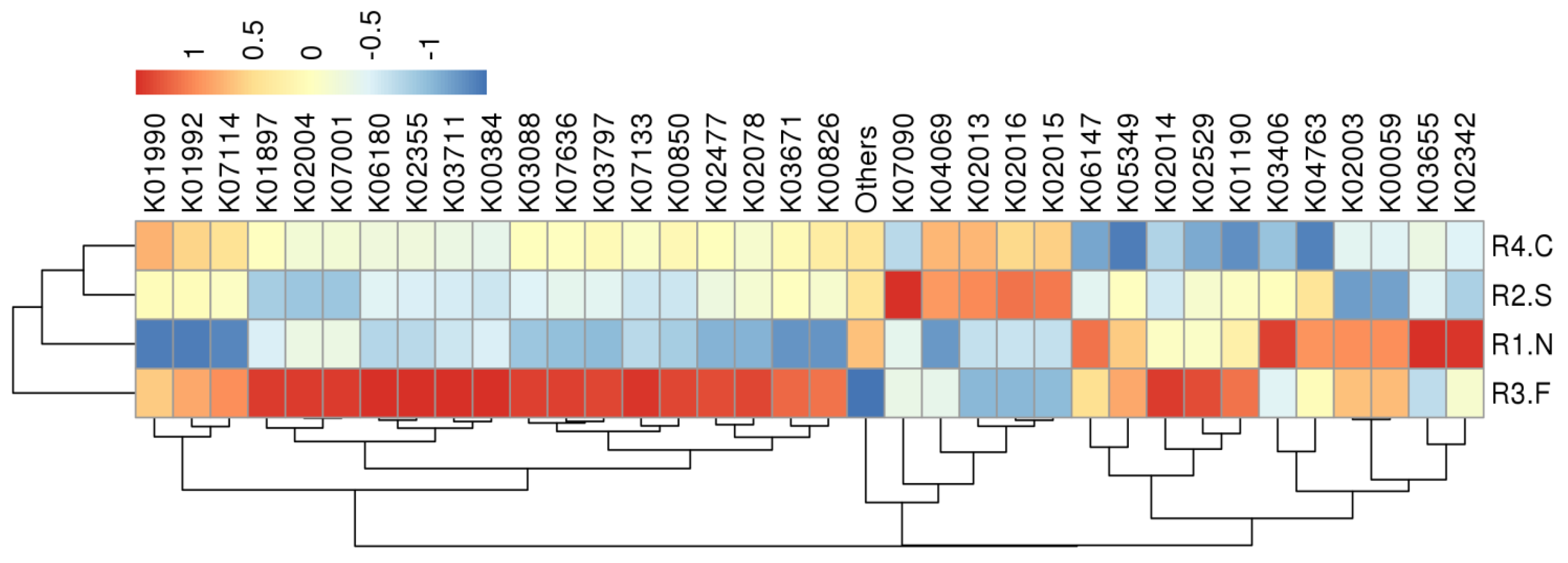Mechanism of Electron Acceptor Promoting Propionic Acid Transformation in Anaerobic Fermentation
Abstract
:1. Introduction
2. Materials and Methods
2.1. Materials
2.2. Experimental Setup
2.3. Experimental Design
2.4. Physicochemical Analysis
2.5. Microbial Community Analysis
3. Results and Discussion
3.1. Propionate Removal Rate
3.2. Changes in Ion Concentration
3.3. Methane Production Rate
3.4. Sludge Morphology Analysis
3.5. Microbial Community Niche under Different Electron Acceptor Systems
3.6. Structure Analysis of Dominant Flora
3.7. Functional Genes Analysis
4. Conclusions
Author Contributions
Funding
Institutional Review Board Statement
Informed Consent Statement
Data Availability Statement
Conflicts of Interest
References
- Bppt, Y.; Singgih, B. Utilization of Residu/Ampas Biogas Production from Bio-Slurry as Organic Fertilizer Resources. Inov. Pembang. J. Kelitbangan 2018, 6, 139–148. [Google Scholar] [CrossRef]
- Wang, L.; Guo, S.; Wang, Y.; Yi, D.; Wang, J. Poultry biogas slurry can partially substitute for mineral fertilizers in hydroponic lettuce production. Environ. Sci. Pollut. Res. Int. 2019, 26, 659–671. [Google Scholar] [CrossRef]
- Halat-Las, M.; Jedynak, P.; Malec, P.; Burczyk, J.; Vilches, A.; Iglesias, K. Application of microbial consortia for biological treatment of post-fermentation effluents from biomethanization of sewage sludge and pig manure. Przem. Chem. 2018, 97, 1189–1194. [Google Scholar]
- Borek, K.; Roman, K. The Analysis of a Prototype Installation for Biogas Production from Chosen Agricultural Substrates. Energies 2021, 14, 2132. [Google Scholar] [CrossRef]
- Sun, Y.; Zhang, Z.; Sun, Y.; Yang, G. One-pot pyrolysis route to FeN-Doped carbon nanosheets with outstanding electrochemical performance as cathode materials for microbial fuel cell. Int. J. Agric. Biol. Eng. 2020, 13, 8. [Google Scholar]
- Stams, A.; Plugge, C.M. Electron transfer in syntrophic communities of anaerobic bacteria and archaea. Nat. Rev. Microbiol. 2009, 7, 568–577. [Google Scholar] [CrossRef]
- Yuan, X.; Li, P.; Wang, H.; Wang, X.; Cheng, X.; Cui, Z. Enhancing the anaerobic digestion of corn stalks using composite microbial pretreatment. J. Microbiol. Biotechnol. 2011, 21, 746–752. [Google Scholar] [CrossRef] [Green Version]
- Luo, Y.; Luo, X.Z.; Zheng, Z.; Chen, G.Y.; Liang, Y.G. Effect of TS loading rates of biogas residue of Spartina alterniflora for secondary anaerobic digestion. Huan Jing Ke Xue 2011, 32, 3425–3428. (In Chinese) [Google Scholar]
- Mao, Z.; Gräßle, F.; Frey, J.; Franchini, P.; Schleheck, D.; Müller, N.; Schink, B. Phosphitispora fastidiosa gen. nov. sp. nov., a new dissimilatory phosphite-oxidizing anaerobic bacterium isolated from anaerobic sewage sludge. Int. J. Syst. Evol. Microbiol. 2021, 71, 005142. [Google Scholar] [CrossRef]
- Cervantes, F.J.; van der Velde, S.; Lettinga, G.; Field, J.A. Quinones as terminal electron acceptors for anaerobic microbial oxidation of phenolic compounds. Biodegradation 2000, 11, 313–321. [Google Scholar] [CrossRef]
- Welte, C.; Deppenmeier, U. Bioenergetics and anaerobic respiratory chains of aceticlastic methanogens. Biochim. Biophys. Acta 2014, 1837, 1130–1147. [Google Scholar] [CrossRef] [Green Version]
- Chen, C.; Shen, Y.; An, D.; Voordouw, G. Use of Acetate, Propionate, and Butyrate for Reduction of Nitrate and Sulfate and Methanogenesis in Microcosms and Bioreactors Simulating an Oil Reservoir. Appl. Environ. Microbiol. 2017, 83, e02983-16. [Google Scholar] [CrossRef] [Green Version]
- Glombitza, C.; Jaussi, M.; Røy, H.; Seidenkrantz, M.S.; Lomstein, B.A.; Jørgensen, B.B. Formate, acetate, and propionate as substrates for sulfate reduction in sub-arctic sediments of Southwest Greenland. Front. Microbiol. 2015, 6, 846. [Google Scholar] [CrossRef] [Green Version]
- Emerson, D. Potential for Iron-reduction and Iron-cycling in Iron Oxyhydroxide-rich Microbial Mats at Loihi Seamount. Geomicrobiol. J. 2009, 26, 639–647. [Google Scholar] [CrossRef]
- Zhang, Q.; Sun, J.; Liu, J.; Huang, G.; Lu, C.; Zhang, Y. Driving mechanism and sources of groundwater nitrate contamination in the rapidly urbanized region of south China. J. Contam. Hydrol. 2015, 182, 221–230. [Google Scholar] [CrossRef]
- Shokoohi, R.; Bajalan, S.; Salari, M.; Shabanloo, A. Thermochemical degradation of furfural by sulfate radicals in aqueous solution: Optimization and synergistic effect studies. Environ. Sci. Pollut. Res. Int. 2019, 26, 8914–8927. [Google Scholar] [CrossRef]
- Lefan, M.; Zhiquan, T.; Junfeng, Z. Removal of NOx from flue gas with iron filings reduction following complex absorption in ferrous chelates aqueous solutions. J. Air Waste Manag. Assoc. 2004, 54, 1543–1549. [Google Scholar] [CrossRef] [Green Version]
- Zhao, Z.; Zhang, Y.; Woodard, T.L.; Nevin, K.P.; Lovley, D.R. Enhancing syntrophic metabolism in up-flow anaerobic sludge blanket reactors with conductive carbon materials. Bioresour. Technol. 2015, 191, 140–145. [Google Scholar] [CrossRef]
- Cieciura-Woch, W.; Binczarski, M.; Tomaszewska, J.; Borowski, S.; Domański, J.; Dziugan, P.; Witońska, I. The Use of Acidic Hydrolysates after Furfural Production from Sugar Waste Biomass as a Fermentation Medium in the Biotechnological Production of Hydrogen. Energies 2019, 12, 3222. [Google Scholar] [CrossRef] [Green Version]
- Achiraya, J.; Kornpong, V.; Malinee, L.; Sumaeth, C. Three-Stage Anaerobic Sequencing Batch Reactor (ASBR) for Maximum Methane Production: Effects of COD Loading Rate and Reactor Volumetric Ratio. Energies 2018, 11, 1543. [Google Scholar]
- Morita, M.; Malvankar, N.S.; Franks, A.E.; Summers, Z.M.; Giloteaux, L.; Rotaru, A.E.; Rotaru, C.; Lovley, D.R. Potential for direct interspecies electron transfer in methanogenic wastewater digester aggregates. mBio 2011, 2, e00159-11. [Google Scholar] [CrossRef] [Green Version]
- Zhang, B.; Li, W.; Xu, X.; Li, P.; Li, N.; Zhang, H.; Sun, Y. Effect of Aerobic Hydrolysis on Anaerobic Fermentation Characteristics of Various Parts of Corn Stover and the Scum Layer. Energies 2019, 12, 381. [Google Scholar] [CrossRef] [Green Version]
- Sarzanini, C.; Bruzzoniti, M.C. Ion Chromatography: Modes for Metal Ions Analysis; CRC Press, Taylor & Francis Group: Boca Raton, FL, USA, 2010; pp. 405–436. [Google Scholar]
- Khan, M.U.; Ahring, B.K. Anaerobic Biodegradation of Wheat Straw Lignin: The Influence of Wet Explosion Pretreatment. Energies 2021, 14, 5940. [Google Scholar] [CrossRef]
- Veluchamy, C.; Raju, V.W.; Kalamdhad, A.S. Prerequisite—An electrohydrolysis pretreatment for anaerobic digestion of lignocellulose waste material. Bioresour. Technol. 2017, 235, 274–280. [Google Scholar] [CrossRef]
- Magoč, T.; Salzberg, S.L. FLASH: Fast length adjustment of short reads to improve genome assemblies. Bioinformatics 2011, 27, 2957–2963. [Google Scholar] [CrossRef]
- Sun, S.; Jones, R.B.; Fodor, A.A. Inference-based accuracy of metagenome prediction tools varies across sample types and functional categories. Microbiome 2020, 8, 46. [Google Scholar] [CrossRef] [Green Version]
- Grigoryan, A.A.; Cornish, S.L.; Buziak, B.; Lin, S.; Cavallaro, A.; Arensdorf, J.J.; Voordouw, G. Competitive oxidation of volatile fatty acids by sulfate- and nitrate-reducing bacteria from an oil field in Argentina. Appl. Environ. Microbiol. 2008, 74, 4324–4335. [Google Scholar] [CrossRef] [Green Version]
- Qiao, W.; Takayanagi, K.; Li, Q.; Shofie, M.; Gao, F.; Dong, R.; Li, Y.Y. Thermodynamically enhancing propionic acid degradation by using sulfate as an external electron acceptor in a thermophilic anaerobic membrane reactor. Water Res. 2016, 106, 320–329. [Google Scholar] [CrossRef]
- Deng, Y.; Xia, J.; Zhao, R.; Xu, J.; Liu, X. Iron-coated biochar alleviates acid accumulation and improves methane production under ammonium enrichment conditions. Sci. Total Environ. 2022, 809, 151154. [Google Scholar] [CrossRef]
- Tanner, R.S. Anoxic life: Biology of anaerobic microorganisms. Science 1989, 245, 201–202. [Google Scholar] [CrossRef]
- Sun, F.; Deng, Q.; Li, X.; Tang, M.; Ma, X.; Cao, X.; Zhou, Y.; Song, C. Organic carbon quantity and quality jointly triggered the switch between dissimilatory nitrate reduction to ammonium (DNRA) and denitrification in biofilters. Chemosphere 2021, 280, 130917. [Google Scholar] [CrossRef]
- Lü, L.; You, W.; Zhang, M.; Wu, P.; Shen, Y.L. Effect of NOx—N Recycling Ratio on Denitrifying Phosphorus Removal Efficiency in the ABR-MBR Combined Process. Huan Jing Ke Xue 2018, 39, 1309–1315. (In Chinese) [Google Scholar]
- Yao, Q.; Huang, J.; Yang, L.; Wu, X.; Hu, X. Characteristic of metabolism for sulfur-containing components during sulfate bioreduction process. J. Environ. Eng. 2018, 12, 2783–2790. (In Chinese) [Google Scholar]
- Goevert, D.; Conrad, R. Stable carbon isotope fractionation by acetotrophic sulfur-reducing bacteria. FEMS Microbiol. Ecol. 2010, 71, 218–225. [Google Scholar] [CrossRef]
- Frederiksen, T.M.; Finster, K. Sulfite-oxido-reductase is involved in the oxidation of sulfite in Desulfocapsa sulfoexigens during disproportionation of thiosulfate and elemental sulfur. Biodegradation 2003, 14, 189–198. [Google Scholar] [CrossRef]
- Haghighatian, S.; Mazarei, E.; Doroodmand, M.M.; Klein, A.; Memarpoor-Yazdi, M. A new whole-cell biocatalyst for sulfur dioxide filtering and degradation. Bioresour. Technol. 2020, 314, 123755. [Google Scholar] [CrossRef]
- Shi, C.; Wang, J.; Peng, S.; Hou, C.; Chen, T.; Yue, Z. Fe3+ enhanced anaerobic digestion process of corn straw. Nongye Gongcheng Xuebao/Trans. Chin. Soc. Agric. Eng. 2013, 29, 218–225. (In Chinese) [Google Scholar]
- Lu, J.; Jin, Q.; He, Y.; Wu, J. Enhanced anaerobic biodegradation of nonylphenol ethoxylates by introducing additional sulfate or nitrate as terminal electron acceptors. Int. Biodeterior. Biodegrad. 2008, 62, 214–218. [Google Scholar] [CrossRef]
- Levar, C.E.; Hoffman, C.L.; Dunshee, A.J.; Toner, B.M.; Bond, D.R. Redox potential as a master variable controlling pathways of metal reduction by Geobacter sulfurreducens. ISME J. 2017, 11, 741–752. [Google Scholar] [CrossRef] [Green Version]
- Dong, H.Y.; Ji, M. Comparative study on biological methane potential and methanogen biodiversity in the anaerobic digestion of excess sludge. Huan Jing Ke Xue 2014, 35, 1421–1427. (In Chinese) [Google Scholar]
- Fang, H.H.P.; Chui, H.; Li, Y. Effect of degradation kinetics on the microstructure of anaerobic biogranules. Water Sci. Technol. 1995, 32, 165–172. [Google Scholar] [CrossRef]
- Weithmann, N.; Mlinar, S.; Sonnleitner, E.; Weig, A.R.; Freitag, R. Flexible feeding in anaerobic digestion—Impact on process stability, performance and microbial community structures. Anaerobe 2021, 68, 102297. [Google Scholar] [CrossRef]
- Lozupone, C.; Knight, R. UniFrac: A new phylogenetic method for comparing microbial communities. Appl. Environ. Microbiol. 2005, 71, 8228–8235. [Google Scholar] [CrossRef] [Green Version]
- Begmatov, S.; Dorofeev, A.G.; Kadnikov, V.V.; Beletsky, A.V.; Pimenov, N.V.; Ravin, N.V.; Mardanov, A.V. The structure of microbial communities of activated sludge of large-scale wastewater treatment plants in the city of Moscow. Sci. Rep. 2022, 12, 3458. [Google Scholar] [CrossRef]
- Wang, S.; Pu, Y.; Wei, C. COD and nitrogen removal and microbial communities in a novel waterfall biofilm reactor operated at different COD/TN ratios. J. Environ. Sci. Health A Tox. Hazard. Subst. Environ. Eng. 2017, 52, 99–105. [Google Scholar] [CrossRef]
- Li, Y.; Dong, R.; Guo, J.; Wang, L.; Zhao, J. Effects of Mn2+ and humic acid on microbial community structures, functional genes for nitrogen and phosphorus removal, and heavy metal resistance genes in wastewater treatment. J. Environ. Manag. 2022, 313, 115028. [Google Scholar] [CrossRef]
- Wang, J.; Liu, T.; Sun, W.; Chen, Q. Bioavailable metal(loid)s and physicochemical features co-mediating microbial communities at combined metal(loid) pollution sites. Chemosphere 2020, 60, 127619. [Google Scholar] [CrossRef]
- Rabus, R.; Wilkes, H.; Schramm, A.; Harms, G.; Behrends, A.; Amann, R.; Widdel, F. Anaerobic utilization of alkylbenzenes and n-alkanes from crude oil in an enrichment culture of denitrifying bacteria affiliating with the beta-subclass of Proteobacteria. Environ. Microbiol. 1999, 2, 145–157. [Google Scholar] [CrossRef]
- Yuan, Y.; Bian, A.; Chen, F.; Xu, X.; Huang, C.; Chen, C.; Liu, W.; Cheng, H.; Chen, T.; Ding, C.; et al. Continuous sulfur biotransformation in an anaerobic-anoxic sequential batch reactor involving sulfate reduction and denitrifying sulfide oxidization. Chemosphere 2019, 234, 568–578. [Google Scholar] [CrossRef]
- Deng, Y.; Xia, J.; Zhao, R.; Liu, X.; Xu, J. Modified biochar promotes the direct interspecies electron transfer between iron-reducing bacteria and methanogens in high organic loading co-digestion. Bioresour. Technol. 2021, 342, 126030. [Google Scholar] [CrossRef]
- Bagg, A.; Neilands, J.B. Ferric uptake regulation protein acts as a repressor, employing iron (II) as a cofactor to bind the operator of an iron transport operon in Escherichia coli. Biochemistry 1987, 26, 5471–5477. [Google Scholar] [CrossRef]
- Cejudo, F.J.; Ferrández, J.; Cano, B.; Puerto-Galán, L.; Guinea, M. The function of the NADPH thioredoxin reductase C-2-Cys peroxiredoxin system in plastid redox regulation and signalling. FEBS Lett. 2012, 586, 2974–2980. [Google Scholar] [CrossRef] [Green Version]
- Kwon, O.; Georgellis, D.; Lin, E.C. Rotational on-off switching of a hybrid membrane sensor kinase Tar-ArcB in Escherichia coli. J. Biol. Chem. 2003, 278, 13192–13195. [Google Scholar] [CrossRef] [Green Version]









| Drug Name | Concentration (g/L) |
|---|---|
| MnSO4 | 0.05 |
| FeSO4·7H2O | 0.1 |
| NiCl2·6H2O | 0.04 |
| CoCl2·6H2O | 0.05 |
| ZnCl2 | 0.13 |
| CuSO4·5H2O | 0.01 |
| KAl(SO4)2·12H2O | 0.01 |
| MnSO4 | 0.05 |
| Reactor Name | Reaction Conditions | Substrate | Influent Concentration (g·COD/L) | Feed In and Out Time Interval |
|---|---|---|---|---|
| R1−N | IS + NO3− 0.03 mmol/L | Sodium propionate + basal medium + 10 mL/L trace elements | S1 8 g·COD/L S2 16 g·COD/L S3 24 g·COD/L | S1 2 d S2 4 d S3 6 d |
| R2−S | IS + SO42− 0.03 mmol/L | |||
| R3−F | IS + Fe3+ 0.03 mmol/L | |||
| R4−CK | IS |
| Sample ID | Chao1 | Goods Coverage | Observed OTUs | Shanon | Simpson |
|---|---|---|---|---|---|
| R1−N | 702.000 | 1.000 | 701 | 6.408 | 0.959 |
| R2−S | 650.050 | 1.000 | 649 | 5.998 | 0.930 |
| R3−F | 609.000 | 1.000 | 609 | 5.936 | 0.918 |
| CK | 558.000 | 1.000 | 558 | 5.785 | 0.922 |
Publisher’s Note: MDPI stays neutral with regard to jurisdictional claims in published maps and institutional affiliations. |
© 2022 by the authors. Licensee MDPI, Basel, Switzerland. This article is an open access article distributed under the terms and conditions of the Creative Commons Attribution (CC BY) license (https://creativecommons.org/licenses/by/4.0/).
Share and Cite
Jing, H.; Li, W.; Wang, M.; Jiao, H.; Sun, Y. Mechanism of Electron Acceptor Promoting Propionic Acid Transformation in Anaerobic Fermentation. Energies 2022, 15, 3947. https://doi.org/10.3390/en15113947
Jing H, Li W, Wang M, Jiao H, Sun Y. Mechanism of Electron Acceptor Promoting Propionic Acid Transformation in Anaerobic Fermentation. Energies. 2022; 15(11):3947. https://doi.org/10.3390/en15113947
Chicago/Turabian StyleJing, Hongjing, Wenzhe Li, Ming Wang, Hao Jiao, and Yong Sun. 2022. "Mechanism of Electron Acceptor Promoting Propionic Acid Transformation in Anaerobic Fermentation" Energies 15, no. 11: 3947. https://doi.org/10.3390/en15113947
APA StyleJing, H., Li, W., Wang, M., Jiao, H., & Sun, Y. (2022). Mechanism of Electron Acceptor Promoting Propionic Acid Transformation in Anaerobic Fermentation. Energies, 15(11), 3947. https://doi.org/10.3390/en15113947







